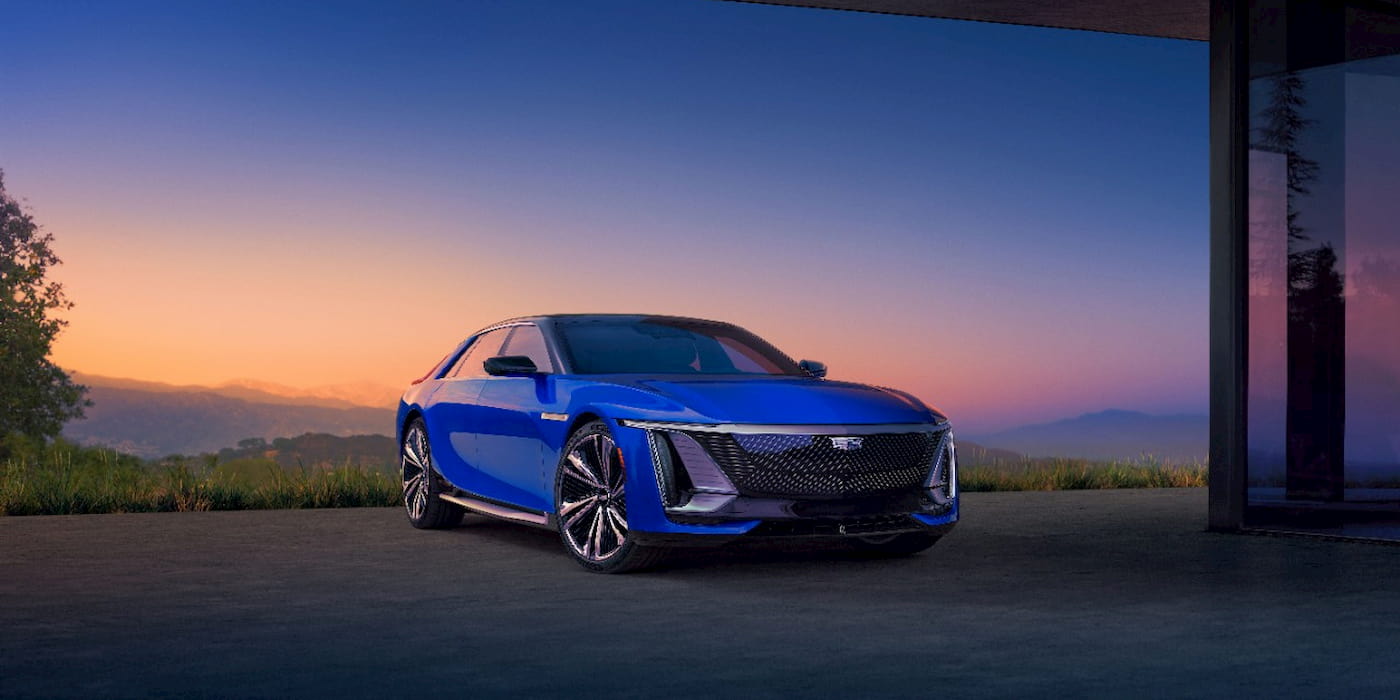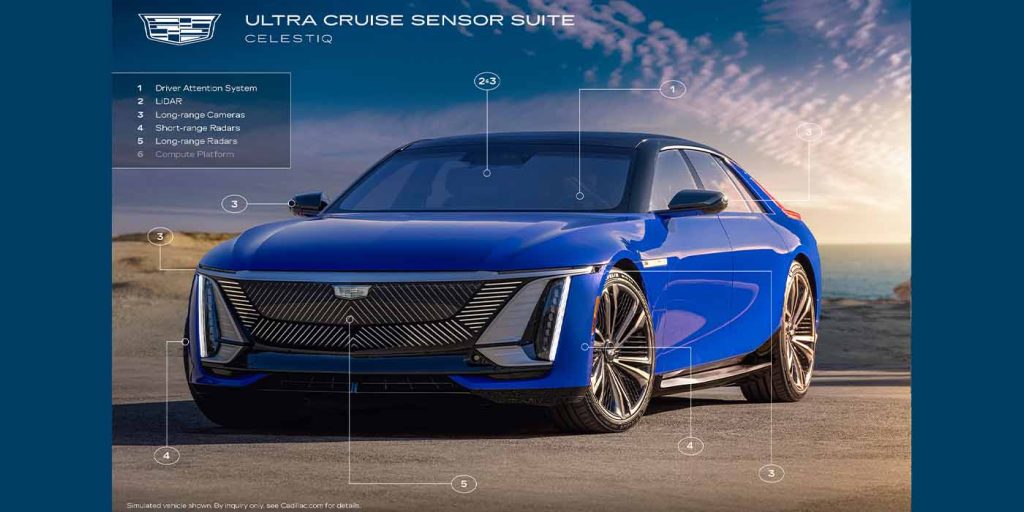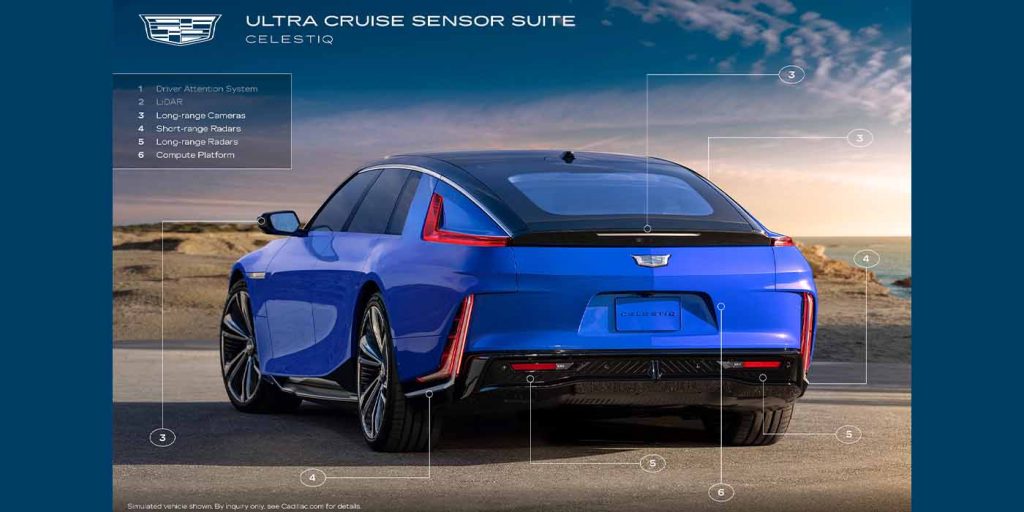
General Motors has shared more details of the technology and future capabilities we can expect to see in its next-generation Ultra Cruise ADAS, which was originally announced during its GM Investor Day presentation last year. The technology will debut on the upcoming premium Cadillac Celestiq EV in early 2024, although the exact driver assistance capabilities deployed at that time remain to be determined. Here’s what we know so far.
Before we dig into the new details of Ultra Cruise, we should start with GM’s ADAS predecessor, Super Cruise. Super Cruise is a hands-free driver assistance feature introduced years ago that uses adaptive cruise control technology and connected services in each GM branded vehicle to navigate LiDAR-enabled map data using real-time positioning, cameras, and sensors.
The result is EVs that can control their own acceleration, braking, and automatic lane changes, but only on compatible roads. The American automaker continues to expand the availability of Super Cruise’s hands-free driving feature on roads throughout North America and has made excellent progress so far.
According to its latest annual ADAS rankings, Consumer Reports gave Super Cruise a score of 75, second only to Ford’s BlueCruise ADAS – both of which bested the likes of Mercedes-Benz and Tesla. During 2022’s GM Investor Day, the automaker shared it was working on its next-generation of ADAS technology called Ultra Cruise.
When GM first unveiled its ultra-lux, hand-built Cadillac Celestiq sedan, we learned it would come equipped with the sensor and software systems to support Ultra Cruise, but those exact capabilities remained vague.
Today, GM has shared more details of the sensors that will comprise Ultra Cruise driving as well as the automaker’s expansion plans for capable roadways around the US and Canada.
Only premium GM EVs will get Ultra Cruise capabilities
At least to start, and as previously mentioned, GM’s plan to initially launch the Ultra Cruise ADAS on the Cadillac Celestiq remain on track, although it is highly unlikely we see the system’s full hands-free potential when the $300,000 EV makes its first deliveries in 2024.
The Celestiq will kick off GM’s lineup of premium EV offerings that will all come equipped with its new sensor suite and applicable software, but which model will follow the Cadillac remains a secret. We have learned the vehicles will feature over 20 different sensors including long and short range cameras and radars, LiDAR (GM wouldn’t share the supplier yet), and an advanced driver monitoring system to ensure the driver remains attentive. GM says the sensors are not redundant but instead fuse together to give full, 360-degree sensory coverage of a given EV.
Due to fact that the driver must remain engaged at all times, GM states the Ultra Cruise ADAS was architected as a Level 2 autonomous driving suite. That said, the company intends to increase the system’s capabilities over time via over-the-air (OTA) updates and expand the domain in which the EVs can safely engage.
When those capabilities roll out, including initially, it will be at GM’s discretion as its main philosophy is ensuring safe deployment and driver confidence in the technology’s capabilities. GM’s chief engineer for Ultra Cruise Jason Ditman spoke to a group of journalists earlier this week:
GM’s fundamental strategy for all ADAS features, including Ultra Cruise, is safely deploying these technologies. A deep knowledge of what Ultra Cruise is capable of, along with the detailed picture provided by its sensors, will help us understand when Ultra Cruise can be engaged and when to hand control back to the driver. We believe consistent, clear operation can help build drivers’ confidence in Ultra Cruise.
The keen focus on safe deployment means we may not see exactly what Ultra Cruise can do for some time. All that said, the Cadillac Celestiq will arrive with all the necessary hardware and software required to operate Ultra Cruise whenever GM feels it is safe.
Ditman told us that component-level testing is underway and all sensors are in the final stages of validation. GM vehicles equipped with Ultra Cruise prototype software are currently being tested at the automaker’s proving grounds in Milford, Michigan, while off-property testing is underway with drivers remaining in control of the steering. GM has yet to test Ultra Cruise hands-free driving on public roads.
The automaker states that Ultra-Cruise has been designed to eventually enable hands-free driving in 95% of all driving situations and will inevitably become accessible on nearly every paved road, city or suburban street, and subdivision in the United States and Canada.
The launch of the Cadillac Celestiq remains on schedule for early 2024 followed by GM’s safe deployment of Ultra Cruise at some point thereafter.
FTC: We use income earning auto affiliate links. More.




Comments